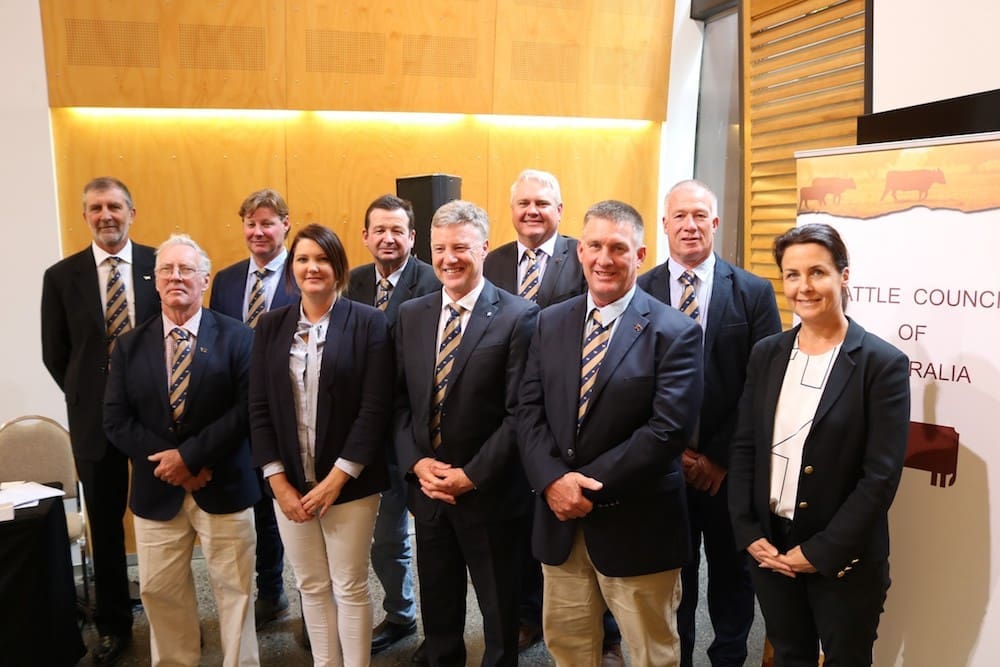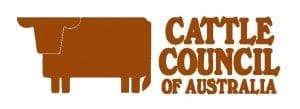
Looking back: Directors of the Cattle Council of Australia board pictured at its annual general meeting in Canberra in 2018 : (from left) Tony Hegarty NSW (president), David Lovelock WA, Geoff Pearson WA, Amanda Giles SA, Markus Rathsmann, NT (vice president), Brett Hall (Tas) David Hill (Qld – Northern Independent Director), Lloyd Hick Qld, Peter Star, Vic and Olivia Lawson (Vic),
FORTY-three years of history as Australia’s national grassfed cattle producer representative body formally ended with a simple vote of the members of Cattle Council of Australia present in Brisbane at its final annual general meeting this morning.
 For an organisation that does most of its work in meetings and negotiations often unseen by the broader industry, it was a perhaps a fitting, if non-fanfare filled, final act for the long-serving national producer council.
For an organisation that does most of its work in meetings and negotiations often unseen by the broader industry, it was a perhaps a fitting, if non-fanfare filled, final act for the long-serving national producer council.
The transition from Cattle Council of Australia to Cattle Australia was formalised just over a month ago on November 4, following a vote by CCA’s membership to accept the new Cattle Australia constitution.
The final step of that transition process was completed late this morning in Brisbane when the board, at the final CCA AGM, voted in favour or a special resolution to change the company’s corporate name from Cattle Council of Australia Ltd to Cattle Australia Ltd.
That simple act brought the curtain down on the operations of an organisation that was formed in July 1979, to bring together for the first time all farmer organisations whose members had beef cattle enterprises.
At the time the organisations had a combined membership of more than 15,000 cattle producers and represented more than 50 percent of Australia’s cattle herd.
Cattle Council of Australia’s mission was to represent and progress the interests of Australian beef cattle producers and to work to ensure compulsory levy funds paid by producers were used in an accountable way.
While a lot of its work may have been conducted in meetings and discussions not visible to most Australian cattle producers on whose behalf the organisation worked, a lot of what it achieved is visible in history.
A lot was clearly achieved along the way by the successive boards of State producer representatives and the surprisingly small teams of full time staff – given the size of the Australian beef industry – that have taken turns to hold the reins over more than four decades.
In the past week conversations with a number of past CCA presidents and CEOs have highlighted some of the council’s defining achievements on behalf of Australian cattle producers since 1979.
Just some, which are highlighted in a separate article, include carcase by description, industry standard language, removal of quota restrictions to key export markets including the US, Europe and Asia, Free Trade Agreements, livestock traceability, the brucellosis and tuberculosis eradication campaign, and development of the grassfed cypher.
In more recent years however Cattle Council of Australia became the target of mounting criticism from detractors, who challenged its ability, due to its specific alignment with SFOs, to serve as a true voice for all cattle producers in Australia.
A lack of resourcing also became an increasing burr under the saddle for Cattle Council, leading it to enter into direct funding agreements with Meat & Livestock Australia in the past 10 years to fund its operations, undermining its independent standing.
Several smaller rival groups sprang up over the past decade claiming to provide an alternative voice for producers, particularly those who chose not to pay membership fees to SFOs.
However none of the start up groups have been able to demonstrate significant producer support outside of their outspoken founders, and certainly none came close to matching the thousands of paying producer members Cattle Council of Australia directly represents through the State Farming Organisation networks.
Pressure to reform
Pressure for reform to make it easier for producers to engage in national policy setting and advocacy resulted in several misfired attempts over the last decade to have Cattle Council and smaller producer groups reach an agreement on a restructure.
Along the way came internal industry reviews, successive senate inquiries and ministerial-imposed restructure processes. Millions of dollars collectively spent and countless hours of attention focused on internal structural issues, while arguably more pressing external threats were not able to be given the time or energy they required.
The primary development to show for all of that was a 2014 decision by Cattle Council of Australia to introduce two new seats for directly elected directors onto its board, alongside eight SFO-appointed directors.
The second major step is effectively unfolding in Brisbane today – the transition of Cattle Council of Australia to Cattle Australia under a new constitution that replaces SFO appointed director seats altogether with directly elected directors across the board.
(The process is still subject to a legal challenge by Cattle Producers Australia which alleges that a previously agreed restructure process to form Cattle Australia was not followed by Cattle Council of Australia. After a recent adjournment, the case is continuing in the Supreme Court of Qld, with no clear indication yet as to when a resolution is likely).
Priorities for Cattle Australia
For the new board of Cattle Australia, challenges – and indeed opportunities – abound.
A lack of continuity and experience at national policy level among the new board nominees is on one hand a challenge, but also ensures the inaugural board starts with new ideas, fresh energy and a clean slate to forge its own path going forward.
Finding a way to secure a sustainable funding stream to resource the new body is a clear priority for the new board.
Calls have never diminished for the peak industry council to be funded in part by proceeds from the cattle transaction levy, but previous Federal Governments have largely rejected the proposition, stating that compulsorily-acquired statutory funding cannot be redirected to advocacy bodies.
Even if the current or a future Government can be convinced to loosen the levy purse strings, legislative experts say it would still take years for the glacial work of parliamentary processes to enable that to take effect.
For now, the new body may have little choice but to continue to rely on levy funding via a service agreement with MLA. It needs money to operate, but that funding stream also perpetuates the upside down ‘master relying on servant’ relationship that has weakened CCA’s oversight ability and fuelled its many detractors in the past.
As noted at the start of this article, many of CCA’s achievements over the years resulted from work that was often not visible to producers across the country, even though the benefits of what was achieved were shared by all producers, not just those who paid membership fees to support the council’s work.
 Finding ways to ensure more producers can see and understand the work it does on their behalf will undoubtedly also a key challenge for Cattle Australia in its first years.
Finding ways to ensure more producers can see and understand the work it does on their behalf will undoubtedly also a key challenge for Cattle Australia in its first years.
The ideal pathway to a sustainable revenue stream will be through convincing producers to pay membership fees by demonstrating they are getting bang for their membership bucks.
Being prepared to ensure the organisation’s voice is heard clearly and fearlessly will be essential to that outcome.
Reform fatigue: Time to focus on bigger issues
After years of division, something producers have long called for in restructure discussions – a direct pathway for individual producers to national representation and policy setting – is in place through Cattle Australia.
There will be elements of Cattle Australia structure and constitution some producers still don’t like. Retiring CCA president Lloyd Hicks makes no bones about the fact the organisation can not and will not be perfect.
But, importantly, for those looking for further change, the opportunity is now there for them to get involved and work for the change they seek from within.
A decade or more of seemingly continuous industry division and focus on internal reform has taken so much energy, expertise and money. What could be achieved if all those resources and expertise across the sector are finally mustered instead toward dealing with the many external issues – and indeed opportunities – continually mounting at beef’s doorstep.
